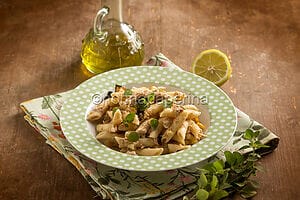Cherries

The properties of cherries
Cheries are nutritious, juicy, and so good that “you can’t stop at one.” It is one of the most beloved fruits ever. Its origin is unknown; however, evidence of its existence dates back to the first millennium BC. It comes in a wide range of forms and colours, though the traditional variety is between one and two centimetres in size and can be any colour from brilliant red to amaranth. Cherries are mostly made of sugar and water, but they also include significant amounts of potassium, phosphorus, magnesium, and the vitamins A and C. The calorie intake is really low, equal to 50 kcal per 100 grammes.
Typically, cherries are fruits of late spring and summer. Harvesting takes place in the months from May to July (no later than the second week in July). The tree is very leafy and almost always exceeds 4 metres in height. The flowers are very beautiful, with a pinkish-white colour.
The varieties of cherries
There are numerous varieties of cherries. Below, we describe the best-known ones in Italy.
- Hard black cherries from Vignola: this is an Emilian variety, characterised by its dark colour and above-average size.
- Arecca: typical of the Campania region, it is characterised by a hard, medium-sized, and light-coloured fruit.
- Burlat: this cherry, which is widely available throughout France, is distinguished by its rounded form, dark but not too dark shade, and incredibly soft pulp.
- Del Monte: typical yellow-and red-coloured cherries that are quite crunchy. It is mostly grown in the Campania region.
- Railroad: dark skin with light coloured pulp. Its distinctive heart-shaped form and robust, nearly crunchy consistency define it.
- Marostica: rounded shape, very firm pulp, and intense red colour. It is grown in Puglia and has a PGI certification.
- Napoleon: a French variety that is loved for its heart shape. The pulp is not overly firm, and it has an incredibly sweet flavour.
How to consume them
Like all fruits, cherries are primarily consumed raw. Cherries, however, can take centre stage in a lot of recipes. The most popular and common preparation is jam, which is excellent for tarts as well as for spreading on toast or bread in general. Generally, they work well as fillers for any kind of pastry, regardless of the type of dough.
Cherries can also be used to make an excellent milkshake as well as an equally tasty granita. In some regions, their uses also include the preparation of liqueurs, although this is limited to some particular varieties.
Some delicious recipes
The cherry is a formidable ally in the kitchen; after all, it is versatile. Its taste, which is slightly sour and sweet, works well for a variety of applications. The aforementioned jam is just one of the many ways to enhance cherries. I therefore had the pleasure of preparing these delectable dishes for you.
Smoothie bowl with cherries: smoothie bowls are smoothies that can be consumed as a dessert. Any fruit is welcome, especially if it is sweet and mushy. The cherries, however, are used here in their whole form, almost as a decoration. As a result, they have an impact on both taste and visual perception.
Bowl with chicken strips and cherries: another bowl in the form of a salad. The use of cherries here is unique, as it is included in a savoury recipe. With its sweetness, this fruit balances and intensifies the flavour of the savoury but delicate chicken as well as the full-bodied wheat and legumes.
Cherry tiramisu: It is a particular dessert that takes inspiration from the original tiramisu. The ladyfingers are not dipped in coffee but rather in a solution of cherry juice and maraschino. Finally, the topping is not made up of cocoa powder but of lightly caramelized cherries.
Cheesecake with cherries: A classic cheesecake is enhanced by the presence of cherries, which intervene in two distinct phases of the recipe: the preparation of the topping and the garnish. In the first case, the cherries are cooked with sugar and softened with starch and water. In the second case, they are placed raw but pitted.
The benefits of cherries
I have already mentioned the properties of cherries, but I think it is useful to delve deeper into the many benefits for the body. For example, cherries help keep the immune system active thanks to the abundance of vitamin C.
Additionally, because they are notably abundant and contain a wide variety of mineral salts, particularly magnesium and potassium, they aid in maintaining the body’s high energy levels.
Cherries, then, help to counteract water retention thanks to their diuretic power, which is supported by the presence of abundant water as well as some specific substances. They even play a role in cancer prevention. The credit for this goes to the presence of some antioxidants, which optimise cellular regeneration processes.
Additionally, cherries are beneficial to the vascular system because they prevent atherosclerosis, and scientific research indicates that they assist the function of the liver and kidneys.
Do cherries have any contraindications?
It’s strange to talk about contraindications regarding a fruit that is good for your health. Basically, contraindications are only reported in the case of excessive consumption. Eating too many cherries, in fact, could increase intestinal transit and generate a mild laxative effect.
It must be acknowledged that these dynamics apply to fruits and vegetables as a whole because they are packed with fibres that, for the most part, set them apart. People with gastrointestinal issues, especially those with irritable bowel syndrome, ought to be cautious when consuming cherries.
It makes one wonder if there are any cherry allergies, intolerances, or sensitivities. It’s true that there is a cherry allergy; however, it should be noted that it is quite uncommon and primarily found in the Mediterranean region. On the other hand, there are systemic and localised symptoms. Nausea, vomiting, diarrhoea, dysphagia, a stuffy nose, and burning eyes resembling urticaria and conjunctivitis are possible side effects.
Since there is no known cure for anaphylactic shock, it is best to avoid the allergen in extremely rare instances. Many people think that cooking can shield them from the worst effects, but this is untrue because the allergen can endure high temperatures.
Cherries and cholesterol—let’s clarify things
Due to this fruit’s goodness, various misconceptions have been created, such as the idea that cherries cause obesity due to their high sugar content. Moreover, it is a misconception that those with high cholesterol can also suffer from this fruit. To put it briefly, cherries are typically associated with fatty foods.
The cherry is not fat in actuality; in fact, its fat content is merely 0.3 grammes per 100 grammes. Furthermore, cherries are beneficial to people with elevated cholesterol levels; in fact, they help maintain healthy LDL (low-density lipoprotein) limits. This is why it’s important to keep in mind that elevated levels of low-density lipoprotein (LDL) can accelerate the development of acute cardiovascular illnesses.
The cherry has numerous other health advantages as well; one of them is its potent anti-inflammatory properties. The term “antioxidant” refers to the compound cyanidin, which can be found in several red fruits. Finally, melatonin, a chemical that encourages sleep, is present in cherries. For this reason, simply supplement your diet with a generous dose of cherries to guarantee a more peaceful night.




















